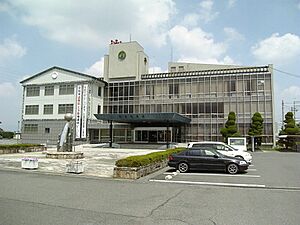Kōryō, Nara facts for kids
Quick facts for kids
Kōryō
広陵町
|
|||
|---|---|---|---|
|
Town
|
|||

Koryo Town Office
|
|||
|
|||

Location of Kōryō in Nara Prefecture
|
|||
| Country | Japan | ||
| Region | Kansai | ||
| Prefecture | Nara Prefecture | ||
| District | Kitakatsuragi | ||
| Area | |||
| • Total | 16.34 km2 (6.31 sq mi) | ||
| Population
(March 31, 2017)
|
|||
| • Total | 35,021 | ||
| • Density | 2,143.3/km2 (5,551.0/sq mi) | ||
| Time zone | UTC+09:00 (JST) | ||
Kōryō (広陵町, Kōryō-chō) is a town located in Kitakatsuragi District, Nara Prefecture, Japan. This town has a very interesting past. It was even a temporary capital of Japan from 640 to 642 AD. One important landmark here is the Kudara Palace.
Even though Kōryō has many farms, it is also famous for making socks. About 40% of all socks produced in Japan come from Kōryō! As of March 2017, the town had a population of 35,021 people. It covers an area of 16.34 square kilometers.
Contents
What Does Kōryō Mean?
The name Kudara in Kudara Palace refers to an ancient Korean kingdom called Baekje. The name "Koryo" also connects to Korea. However, the Japanese characters (kanji) used for the town's name actually mean 'many tombs'. This is because Kōryō has a very high number of ancient burial mounds, called kofun, in Japan.
A Glimpse into Kōryō's History
Kōryō played an important role in Japan's history. In the year 640, the capital of Japan moved from Kashihara to Kōryō. The Kudara Palace became the main center of power. But this was only for a short time. In 642, the capital was moved again, this time to Asuka.
The Kōryō we know today was officially created in 1955. The town celebrated its 60th anniversary in 2015.
Exploring Kōryō's Geography
Kōryō has two main areas: Mamigaoka and Kasa. Mamigaoka is a newer part of town. It has many modern shops and restaurants. This area is generally more developed. Kasa, on the other hand, is sometimes called 'Old Town'. It has a more traditional feel.
Famous People from Kōryō
Kōryō is home to some well-known athletes.
- Tadahiro Nomura is one of Japan's most famous judo competitors.
- Toyokazu Nomura is also a retired judoka.
See also
 In Spanish: Kōryō (Nara) para niños
In Spanish: Kōryō (Nara) para niños




